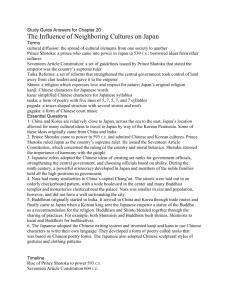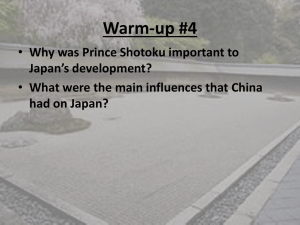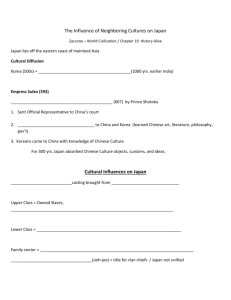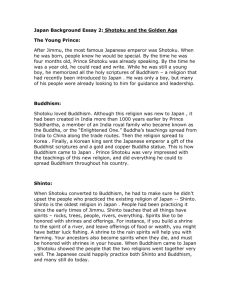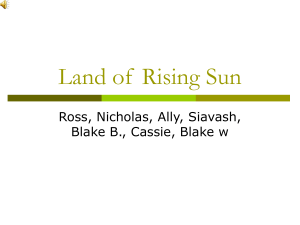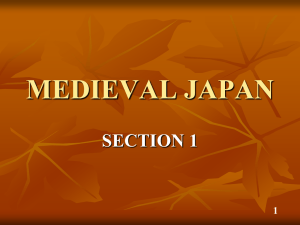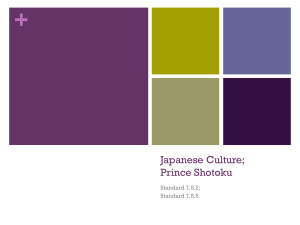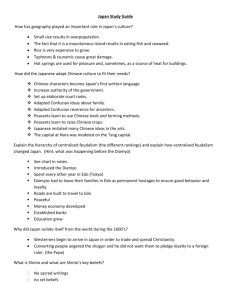Background Essay 2.doc
advertisement
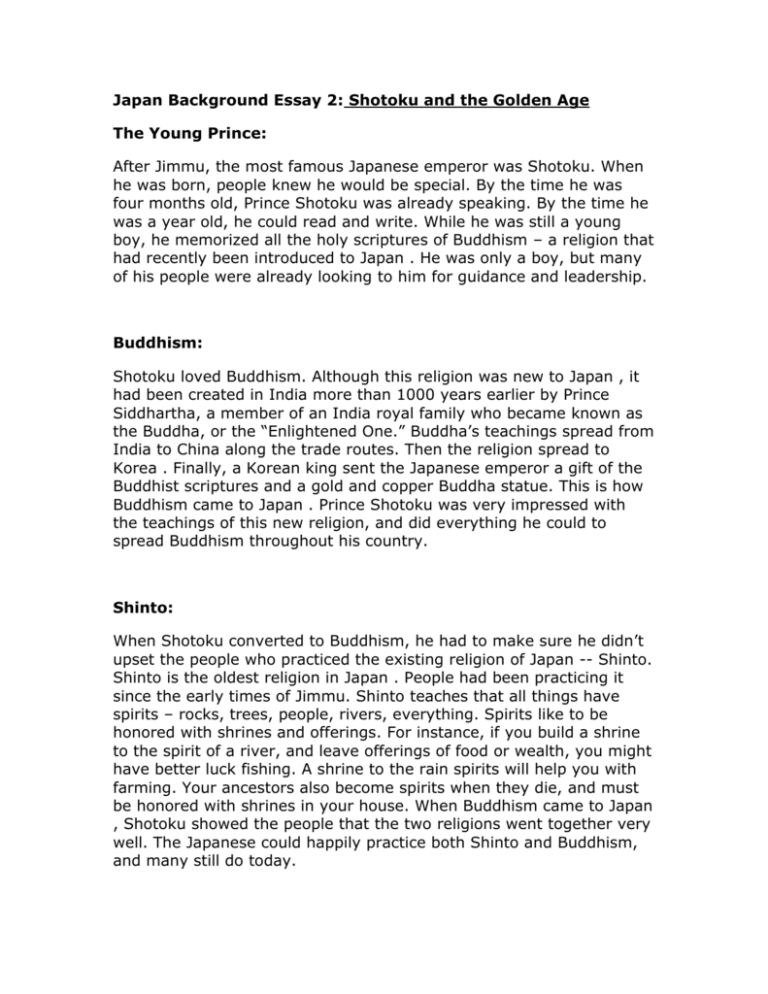
Japan Background Essay 2: Shotoku and the Golden Age The Young Prince: After Jimmu, the most famous Japanese emperor was Shotoku. When he was born, people knew he would be special. By the time he was four months old, Prince Shotoku was already speaking. By the time he was a year old, he could read and write. While he was still a young boy, he memorized all the holy scriptures of Buddhism – a religion that had recently been introduced to Japan . He was only a boy, but many of his people were already looking to him for guidance and leadership. Buddhism: Shotoku loved Buddhism. Although this religion was new to Japan , it had been created in India more than 1000 years earlier by Prince Siddhartha, a member of an India royal family who became known as the Buddha, or the “Enlightened One.” Buddha’s teachings spread from India to China along the trade routes. Then the religion spread to Korea . Finally, a Korean king sent the Japanese emperor a gift of the Buddhist scriptures and a gold and copper Buddha statue. This is how Buddhism came to Japan . Prince Shotoku was very impressed with the teachings of this new religion, and did everything he could to spread Buddhism throughout his country. Shinto: When Shotoku converted to Buddhism, he had to make sure he didn’t upset the people who practiced the existing religion of Japan -- Shinto. Shinto is the oldest religion in Japan . People had been practicing it since the early times of Jimmu. Shinto teaches that all things have spirits – rocks, trees, people, rivers, everything. Spirits like to be honored with shrines and offerings. For instance, if you build a shrine to the spirit of a river, and leave offerings of food or wealth, you might have better luck fishing. A shrine to the rain spirits will help you with farming. Your ancestors also become spirits when they die, and must be honored with shrines in your house. When Buddhism came to Japan , Shotoku showed the people that the two religions went together very well. The Japanese could happily practice both Shinto and Buddhism, and many still do today. Buddhism spreads: Prince Shotoku paid to have Buddhist temples and statues built all over Japan. One great complex of temples holds something very special. According to legend, when Prince Shotoku was only a year old, he was praying when the left eyeball of Buddha appeared in his hands. This was seen as a sign of special favor from Buddha – Shotoku had seen the true way, just as Buddha had done. Later, the eyeball was placed at the temple Shotoku built. Soon, the scriptures of Buddhism spread across Japan . Monasteries were constructed where people could become monks. A monk is someone who spends his whole life studying a religion and trying to be holy. There are still many Buddhist monks in Japan . Shotoku the Statesman: Shotoku wasn’t just religious. He was a great national leader, too. While the young prince was growing up, his aunt was the empress, but when Shotoku was 21, the empress decided to make Shotoku regent. This meant that Shotoku would rule in her name, and have complete control of the government. The prince made contact with Korea and China and started a program to bring Chinese and Korean teachers to Japan , so the Japanese people could learn astronomy, geography, medicine, and other advanced sciences. To attract the best teachers, he awarded them high social rank and generous pay. This started a golden age for Japan with new learning and cultural advancement. Accomplishments: Prince Shotoku also made the Japanese government much more efficient. He imitated the Chinese centralized government, where the emperor controlled almost everything directly from the capital city. This kept the local warlords from fighting with each other. He tried to base his rule on the peaceful principles of Buddhism – love, honesty, goodness. Shotoku wrote a new code of laws. He set down guidelines for moral conduct that everyone in his government had to follow. Under his rule, there was peace in all Japan . His people loved him so much, that they didn’t object even though he made huge changes to the country. The whole nation was sad when Shotoku died of illness in 622 A.D. Chinese Influence: During Shotoku’s rule, and for hundred of years after, the Japanese were fascinated by the much older Chinese culture. A university was established for Japanese royalty and their friends, where Chinese speech and writing were taught. Chinese was considered the highclass language to know. It was the preferred form of communication, and most poetry was written in Chinese. The Japanese emperors also tried to imitate the lavish lifestyles of the Chinese emperors. It was said that when the Chinese emperor built a capital, two million men were set to work, and his fleet of pleasure boats on the Yellow River was towed by 80,000 men. When he traveled on land, his caravan stretched for 300 miles. The Japanese emperors couldn’t match that, but they tried. The paid for fancy paintings, bronze sculptures, silks, stone and wood carvings. For centuries, Japanese art looked a lot like Chinese art. Women in Japan: Women were not equal to men in early Japan , but they were honored, and they had some freedoms that women in other early societies did not have. They could own their own property, and they could inherit property. Japanese women could also be educated to read and write. Some of the best books written in early Japan were by female authors, who wrote in Japanese, not in Chinese as the male authors preferred. The 54-book series The Tale of the Genji, written by Lady Murasaki, tells of what life was like as a member of the royal family in early Japan . Women were also known for their bravery. Once, during a battle with the white hairy barbarians, a general’s fort was about to be overrun. He started to run away but his wife grabbed him and teased him about being a coward. He was so embarrassed he stayed. Then his wife gathered the other women together and they all made plucking sounds like bow strings. The barbarians, thinking there was a great army waiting behind the walls, decided to retreat. Later, the general reorganized his army and led them to victory. Questions for Shotoku: 1. 2. 3. 4. 5. What religion began in India and spread to Japan by 552 A.D.? What does the Shinto religion believe in? What language did Japanese men prefer for writing poetry? What rights did women have during Shotoku’s time? How did Shotoku attract the best teachers from China and Korea? 6. According to legend, what strange relic appeared in Shotoku’s hand when he was praying? 7. How did Shotoku die? 8. How old was Shotoku when he became regent of Japan ? 9. What was the Tale of the Genji? 10.Accordingto legend, how did a group of women once save Japanese army from barbarians? Bio-Poem Your Task: Choose a person we have studied this unit. Use your notes and the textbook to complete the information below. Each answer should be a line in your poem. Line 1 - �Name: Line 2 - Three traits: Line 3 - He / she is from: Line 4 - He / she cares deeply about… Line 5 - He / she feels… Line 6 - Three more traits Line 7 - He / she gives… Line 8 - He / she fears… Line 9 - He / she would like to see… Line 10 - name, Years of life: Example: Jackie Robinson Talented, Black, Pioneer He is from Georgia He cares about representing his people He feels black athletes should be allowed to play Leader, Symbol, Baseball Player He gives hope to the oppressed He fears threats from racists He would like to see equality between races Jackie Robinson (1919-1972) Prince Shotoku A great regent, adopted Chinese culture, new ideas He is from Japan He cares about order in families and religion He feels Confucianism should be spread out through Japan Changer, leader, admired He gives new ideas to Japan He fears his new ideas/changes wont be followed He would like to see everyone following his orders and rules Prince Shotoku (573-621)
